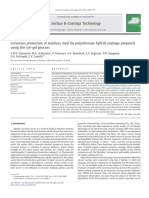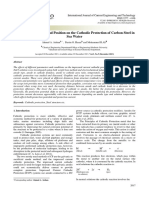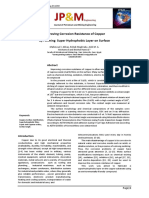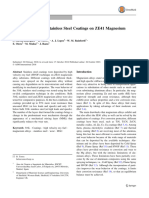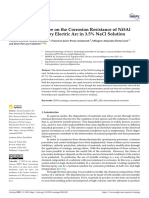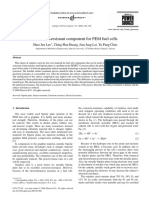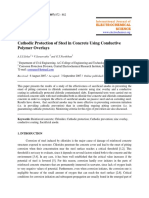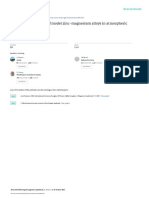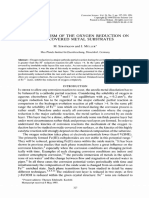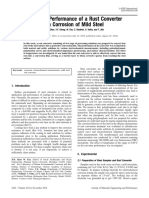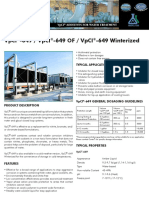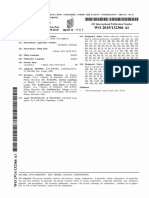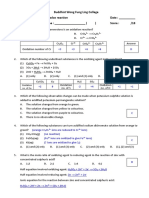Lifetime Prediction For Organic Coatings On Steel and A Magnesium Alloy Using Electrochemical Impedance Methods
Lifetime Prediction For Organic Coatings On Steel and A Magnesium Alloy Using Electrochemical Impedance Methods
Uploaded by
Omar MorteoCopyright:
Available Formats
Lifetime Prediction For Organic Coatings On Steel and A Magnesium Alloy Using Electrochemical Impedance Methods
Lifetime Prediction For Organic Coatings On Steel and A Magnesium Alloy Using Electrochemical Impedance Methods
Uploaded by
Omar MorteoOriginal Title
Copyright
Available Formats
Share this document
Did you find this document useful?
Is this content inappropriate?
Copyright:
Available Formats
Lifetime Prediction For Organic Coatings On Steel and A Magnesium Alloy Using Electrochemical Impedance Methods
Lifetime Prediction For Organic Coatings On Steel and A Magnesium Alloy Using Electrochemical Impedance Methods
Uploaded by
Omar MorteoCopyright:
Available Formats
CORROSION SCIENCE
Lifetime Prediction for Organic Coatings
on Steel and a Magnesium Alloy
Using Electrochemical Impedance Methods✫
J.R. Scully* and S.T. Hensley**
ABSTRACT oxidation and reduction of water reaction rates that occurred
at even the smallest defect sites and from the greater
solubility of magnesium hydroxide (Mg[OH]2). These findings
Electrochemical impedance studies were conducted on an
imply that more conservative coating performance criteria
epoxy polyamide-coated AISI 1010 steel (UNS G10100) and
than traditionally envisioned for steel in neutral salt water
an epoxy/chromate conversion-coated magnesium (Mg) alloy
might be necessary for Mg.
ZE41A-T5 (UNS M16410). Results were compared to
evaluate the general applicability of various impedance- KEY WORDS: breakpoint frequency, coating resistance,
derived measures of coating performance for radically corrosion, electrochemical impedance, epoxy, impedance, life
different metal substrates. Both coating systems were prediction, magnesium, ocean water, sodium chloride, steel,
immersed in room-temperature aqueous sodium chloride UNS G10100, UNS M16410, ZE41A-T5
(NaCl) solution of near neutral pH. Correlation of impedance
parameters obtained early in exposure with long-term visual INTRODUCTION
appearance demonstrated that low-frequency impedance
(< 10 mHz), coating resistance, breakpoint frequency, phase
angle minimum, and saddle frequency associated with the The notion that the corrosion performance of an
phase angle minimum forecasted the long-term performance organic coated metal could be evaluated by
of both systems. Impedance-based parameters adequately characterization of its ionic resistance first was proven
estimated the defect areas associated with corrosion sites by Bacon, et al.1 Mayne found that the modest
that penetrated the organic coating but were unable to inhibition of corrodant (oxygen [O2] and water) ingress
estimate the areas associated with coating blisters. More afforded by organic coatings could not explain the
conservative impedance-based criteria had to be used for the protection mechanism of organic coatings on steel.2 A
coated Mg alloy than for the coated steel in predicting long- protective coating restricts interaction between anodic
term performance. It was hypothesized that differences in the
and cathodic sites at the coating-metal interface partly
critical impedance thresholds resulted from rapid Mg
by impeding penetration of the electrolyte but, more
importantly, by minimizing formation of a bulk
electrolyte phase at the coating-metal interface. Anodic
✫
Submitted for publication August 1993; in revised form, April 1994. and cathodic electron transfer reactions occur readily
Presented as paper no. 359 at CORROSION/93, March 1993, New
Orleans, LA. in the presence of a bulk electrolyte phase. These
* Center for Electrochemical Science and Engineering, Department of processes result in corrosion product formation and
Materia!s Science and Engineering, Thornton Hall, University of Virginia,
Charlottesville, VA, 22903-2442. hydroxyl ion generation, respectively. Hydroxyl ions
** Center for Electrochemical Science and Engineering, Department of and corrosion products both are capable of inducing
Materia!s Science and Engineering, Thornton Hall, University of Virginia,
Charlottesville, VA, 22903-2442. Present address: International Paper,
coating disbondment. Therefore, coating damage and
Texarkana, TX, 75572. delamination occur at coating defects or coated areas
0010-9312/94/000167/$5.00+$0.50/0
CORROSION–Vol. 50, No. 9 © 1994, NACE International 705
CORROSION SCIENCE
of low resistance. Thus, the main role of a barrier-type (16 µm to 20 µm thick) over conversion-coated or
organic coating is to adhere to the substrate and anodized Mg.10 It was proposed that the anodized
maintain high ionic resistance, which inhibits the ability substrate provided excellent bonding for an organic
of local anodes and cathodes to support electron coating, but that a final epoxy resin thickness of 16 µm
transfer reactions at appreciable rates. to 20 µm was required to properly seal the pores in the
A review of the literature in 1979 suggested anodized layer.10 The LF impedance was a good
coatings with a “critical” or threshold resistance of measure of coating performance. However, impedance
< 107 Ω per cm2 of measured surface area are not values have not been correlated extensively with
protective.3-4 Consequently, determination of the coating lifetimes for coated Mg because of the
electrical resistance of the coating, the defect area of relatively short exposure periods used.
the coating, and the anodic-to-cathodic site density Moreover, critical or threshold impedance values
provides a figure of merit describing the degree of used as indicators to forecast a high probability of
protection provided by a coating. coating failure after much longer exposure have not
Electrochemical impedance provides a means to been compared for organic coatings on steel and Mg.
estimate some of the important electrical and physical The present study had three objectives. The first
coating parameters mentioned above. Although was to assess the utility of equivalent circuit models
electrochemical impedance spectroscopy (EIS) developed for coated steel for use with coated Mg. The
methods have been applied to the study of electro- second was to determine whether the most significant
chemical processes for more than three decades, they impedance parameters in terms of ability to forecast
first were used to probe the frequency dependence of long-term performance for coated steel applied equally
the electrical and electrochemical characteristics of well to Mg. The third was to determine whether the
coated metal surfaces in the early 1980s.5-6 Studies critical or threshold impedance values obtained at early
aimed at exploring the utility of impedance techniques exposure times forecasted later performance.
for lifetime prediction of coatings on steels demon-
strated that certain impedance parameters measured EXPERIMENTAL PROCEDURES
after several weeks of exposure correlated well with AND DATA INTERPRETATION
the coating performance after > 1 y.7-8 Important
impedance parameters included the low-frequency Materials
(LF) impedance magnitude (e.g., ≤ 10 mHz), coating Cold-rolled AISI 1010 steel (UNS G10100)(1)
resistance (Rd), and breakpoint frequency. was coated with an epoxy polyamide primer coating
Tait, et al., found aerosol coating cans had (Mil-24441) by a dip application process described by
service lifetimes > 2 y when the pore resistance of the ASTM Standard D 823.11
coating was > 109 Ω-cm2 after 100 days of exposure.9 Composition of the steel was 0.08% to 0.13 %
Lifetimes were < 1 y when the corrosion resistance carbon (C), 0.3% to 0.6 % manganese (Mn), 0.04%
was < 107 Ω-cm2 within the same period.9 These phosphorus (P), and 0.05% sulfur (S). Panels first were
results were generalized for tin-free steel with an degreased in xylene. Coatings then were applied in
organic coating, coated tin-plate steel as well as 25-µm to 30-µm increments for each dip. EIS studies
organic-coated aluminum. were done for nominal coating thicknesses of 25 µm,
In agreement with Leidheiser’s review3-4 and Tait’s 55 µm, 150 µm, and 180 µm. Exposures were
findings,9 Scully found epoxy polyamide-coated steel conducted in ASTM artificial ocean water (ASTM
performed well for several years if the LF impedance Standard D 1141) at room temperature.12 Experimental
(e.g., at 1 mHz and 10 mHz) observed in the first details have been given elsewhere.7
several months was > 107 Ω-cm2.7 Composition of the Mg alloy ZE41A-T5 (UNS
While several correlations exist for barrier coatings M16410) was 3.5% to 5.0% zinc (Zn), 0.75% to 1.75%
on steel, less information is available for coated cerium (Ce), 0.4% to 1.0% zirconium (Zr), 0.15% Mn,
magnesium (Mg). 0.10% copper (Cu), 0.01% nickel (Ni), 0.30 total
Conversion-coated and anodized Mg alloy AZ31 others, and balance Mg.
with an epoxy coating also has been examined by The Mg alloy was chromate conversion-coated in
impedance methods.10 Samples were exposed for 60 a dichromate bath in accordance with AMS 2475E.13 A
days. LF impedance at 10 mHz of > 108 Ω-cm2 were baked-on epoxy (Araldite 961†) was applied subse-
obtained for 2 or 3 layers of an epoxy resin coating quently to 25-µm to 37-µm thicknesses. Panels then
were degreased in 1,1,1-trichloroethane. Tests were
conducted in aerated 5% sodium chloride (NaCI) at
(1)
UNS numbers are listed in Metals and Alloys in the Unified Numbering room temperature.
System, published by the Society of Automotive Engineers (SAE) and
cosponsored by ASTM. A subset of the total population of replicate panels
†
Trade name. was treated in boiling oil (Canadian Exxon 2380†), at
706 CORROSION–SEPTEMBER 1994
CORROSION SCIENCE
164°F (73.3°C), 232°F (111.1°C), and 300°F (148.9°C)
prior to exposure in 5% NaCI at room temperature.
This treatment was implemented to simulate exposure
to aircraft engine fluids. Virtually no long-term adverse
effect of the oil treatment was detected for the panels (a)
tested. Oil inhibited the corrosion of bare ZE41A-T5.
Degradation of the total population of coated Mg
panels was dominated by the initiation and growth of
coating defects that were more or less independent of
the oil pretreatment. The present work was intended to
address the forecasting ability of impedance methods
regardless of the exact processing conditions.
Experimental Methods
EIS data were collected over a frequency range of
1 mHz or 10 mHz to 65 kHz or 100 kHz. Spectra were
acquired at selected times during the exposure period.
(b)
Earlier steel work was performed using either a B.C.
1200† potentiostat and Solartron 1250† frequency FIGURE 1. Electrical equivalent circuit models describing
response analyzer (FRA).7 Coated Mg was investi- coated metal systems: (a) defect-free coating and (b) organic
gated using either a Princeton Applied Research 273A† coating containing defects. (Rt = charge transfer resistance
potentiostat with a 5310† lock-in analyzer, or a PAR associated with corrosion at exposed metal sites).
273A† potentiostat/Solartron 1255† FRA. Data
acquisition was achieved using internal software7 in the
former case and either the PAR 388† software or
ZPLOT† in the latter. A three-electrode electrochemical Data Analysis
configuration was used with a clamp-on electrolyte cell The equivalent electrical circuit models in Figures
attached by a rubber O-ring. A 13-cm2 test area was 1(a) and (b) were used for coated steel and Mg.
used for steel specimens. A 10-cm2 test area was used For the coated Mg system, the EIS circuit
for coated Mg. A silver-silver chloride (Ag-AgCI) parameters associated with Figure 1 were determined
reference electrode exposed to the NaCI solution was with a commercially available software. Capacitances
used in both cases, along with a platinized mesh were modeled either as ideal capacitors (C) such that
counter electrode. the admittance = jC, where is the frequency in
Experiments were conducted at the open-circuit rad/s, j = [–1]1/2, or as constant-phase elements
potential (OCP). OCP obtained for the uncoated alloys (admittance = jnYo where 0 < n < 1 and Yo is a
was applied potentiostatically in cases where coatings parameter describing the apparent capacitance.
of high integrity made determination of a stable OCP Circuit parameters were determined by a nonlinear
difficult. In the case of AISI 1010 steel, OCP of the least-squares fitting analysis procedure.
bare steel was –0.6 to –0.7 VAg-AgCI. In the case of the For coated steel, impedance parameters were
Mg alloy, the chromate conversion-coated OCP was obtained using an iterative procedure whereby the
≈ –1.6 VAg-AgCI. Alternating current (AC) amplitudes of synthetic spectra for selected impedance parameters
10 mV were applied. For high-quality coatings, this were compared to experimental spectra and updated
amplitude was increased to 100 mV or 300 mV to until a good correspondence was achieved.16 In this
improve the signal-to-noise ratio. Some caution is procedure, intrinsic area-specific resistances and
warranted with the use of large amplitudes since the capacitances (coating defect [rd], corrosion charge
coating could be damaged, and nonlinearities in the transfer resistance [rt], and double-layer capacitance
EIS response might be introduced. [Cdl]) were held constant.16 The defect area (Ad) was
Panels were rated visually at various times periods varied to model the increasing coating porosity associ-
(steel) and after 120 days (Mg) using the system ated with various thicknesses of epoxy polyamide on
described by ASTM Standard D 610 for corrosion steel.16
sites14 or for blisters given by ASTM Standard D 714.15 The defect area could be estimated from the high-
However, the area scale used for D 610 also was frequency and low-frequency breakpoints (fh and fl,
applied to blisters. This scale is 9 (0.03%), 8 (0.1%), respectively), which have been defined by Hack and
7 (0.3%), 6 (1%), 5 (3%), 4 (10%), 3 (16%), 2 (33%), Scully16 and Haruyama, et al.17
and 1 (50%), where the percent in parenthesis is the fl is favored for small defect areas.16 fh and fl are
area percent corroded or blistered. linear functions of defect area over a broad range of
CORROSION–Vol. 50, No. 9 707
CORROSION SCIENCE
method.6,19 However, Haruyama, et al., pointed out that
a low value of at blisters can be accounted for by the
electromigration of Cl– or Na+ to the anodic or cathodic
sites under the blister to maintain charge neutrality.17
Others have argued that the approach is suited
particularly well to coating defects such as pores that
are open to the electrolyte.16 For these types of
defects, it is theorized that approaches the resistivity
near or even below that of the external electrolyte
(12 Ω-cm to 25 Ω-cm), which is much less than that of
the intact coating.16 It is well established that occluded
sites may lead to increased ionic concentrations if the
long diffusion length minimizes the transport of soluble
corrosion products into the external solution. With
FIGURE 2. Rd as a function of exposure time for epoxy these possibilities and limitations in mind, the data for
polyamide-coated steel for various coating thicknesses. Results the coated steel and Mg systems could be analyzed.
are shown for replicate specimens at each thickness.
RESULTS AND DISCUSSION
EIS Characterization
defect areas, with certain simplifying assumptions. 16 of Epoxy Polyamide-Coated Steel
Breakpoint frequency also is dependent on the coating The EIS responses of various coating thicknesses
dielectric constant and resistivity, and these param- on steel have been reported elsewhere.7 Rd as a
eters are unlikely to remain constant or change with function of exposure time is shown in Figure 2 for a
time so as to offset each other perfectly. Therefore, the variety of coating thicknesses. Gradual decreases in
approximating nature of the breakpoint frequency resistance were observed for all coatings. Very low
approach cannot be overemphasized. initial Rd values were observed for thin coatings (20 µm
For larger defect areas, fh is used.16-17 A phase and 55 µm) almost immediately. Corrosion sites were
angle minimum (⌽min), occurring at intermediate detected visually at early times for single-layer
frequencies, also can be exploited to examine coating coatings. Multilayer coatings, especially the 116-µm-
deterioration. ⌽min arises as a result of a separation of thick and 150-µm-thick coatings showed no visible
the coating and interfacial resistive-capacitive (RC) signs of deterioration until well after 100 days.
time constants depicted in Figure 1(b) with Significant changes in the EIS response occurred
deterioration. The frequency associated with ⌽min (fmin) before this time. The low initial values of Rd for the thin
and ⌽min itself have been found useful for character- coatings (≤ 25 µm) were best accounted for by an
izing coatings on metals.18 fmin is proportional to the increased population of pre-existing defect areas with a
defect area raised to the 1/2 power, and tan ⌽min is decreasing number of coating layers and, hence, a
inversely proportional to the defect area raised to the decreasing total coating thickness.
1/2 power.18 Use of a combination of fmin and ⌽min In the case of the 20-µm-thick coating, an intrinsic
provides a method for distinguishing between changes value of 1010 Ω-cm to 1014 Ω-cm results in an area
in coating defect resistivity and defect area.18 The specific Rd of 107 Ω-cm to 1011 Ω-cm2 for a 10-µm
formal derivations used for fh and the saddle frequency coating. An alternative view is that a 20-µm-thick
analysis methods have been discussed elsewhere.16-20 coating containing an equal population of substrate
Controversy exists as to how sensitive fh is to the penetrating coating defects as a 200-µm-thick coating
area associated with blisters.19-20 If the coating should have produced an Rd value that is only one-
resistivity () is the same over blisters and well-bonded tenth of the 200-µm coating’s Rd based on difference in
coated areas, then a decrease in the defect resistance thickness. Rd for the 180-µm-thick coating was
of the coating (Rd) and, concurrently, an increase in fh 109 Ω-cm2 just after exposure, implying that a
does not occur with disbondment.19 Central to this 108 Ω-cm2 resistance should have been obtained for
controversy, then, is the value of and its meaning. It the 20-µm-thick coating. Thus, the observed extremely
has been asserted that remains high over delamina- low Rd for the single and 2-layer coating thicknesses
ted areas of the coating.6,19 However, these claims are just after exposure could not be accounted for by
based on the measurement of the resistivity of geometric changes in coating thickness alone. Such
detached films and not that of actual blisters. It is true behavior would be described best by pre-existing open
that delaminated coatings with a high are less likely defects or pores that penetrated to the metal substrate.
to be detected by the breakpoint frequency analysis Hence, Rd was a good measure of the initial defect
708 CORROSION–SEPTEMBER 1994
CORROSION SCIENCE
area of the coating. Indeed, assuming penetration of
the electrolyte in a single pre-existing pore and that this
defect resistance dominated Rd described by Figure 1,
an initial defect area of ≈ 10–4 cm2 is suggested.
As discussed earlier, fh increases linearly with
increasing defect area under certain simplifying
assumptions. Figures 3 and 4 illustrate the differences
in breakpoint frequency observed as a function of
exposure time for the 55-µm-thick coatings compared
to the 150-µm-thick coatings. Visual indications
(ASTM D 610 rating of 9) of as little as 0.03% actively
corroding area (4 x 10–3 cm2) were not detected until
after 100 days of exposure in both cases, yet fh was
sensitive enough to pick up increases in the coating
defect area. These data indicate that the breakpoint FIGURE 3. Relationship between breakpoint frequency and
frequency analysis method is a useful approach for exposure time for a 55-µm-thick epoxy polyamide-coated
quantifying the development of low resistance defect steel. Results are shown for replicate specimens.
areas prior to visual observation of corrosion. A
correlation exists between breakpoint frequency and
visual assessment of defect area, but a rigorous
assessment of whether blistered areas were detected
accurately by the breakpoint frequency was not
possible using these data.
A model was developed subsequently to describe
the influence of small defect areas of extremely low
intrinsic resistivity on the EIS response of coated
metals.16 This model was based on the assumption
that decreases in Rd and increases in breakpoint
frequency correspond strictly with the growth of
localized pre-existing corrosion sites of low intrinsic
resistivity (e.g., approaching that of the bulk electro-
lyte). This model was not intended to describe the
growth of large delaminated areas nor that of blisters in
cases where the magnitude of of the detached FIGURE 4. Relationship between breakpoint frequency and
coating remains high. The model accurately represen- exposure time for a 146-µm- to 160-µm-thick epoxy polyamide-
ted cases where the actively corroding area was of coated steel. Results are shown for replicate specimens.
similar dimensions as the area of low resistance
associated with the pores in the coating.
Figures 5 and 6 show synthetic computer-
generated EIS data in the Bode magnitude and phase impedance spectrum was collected immediately after
angle formats that resulted strictly from changes in immersion to avoid delamination and corresponding
defect area. The assumed circuit model parameters unknown changes in the defect area. The known
are given in Figure 7. All resistance and capacitance defect area in this case increased instantaneously
parameters remained fixed, except for the defect area from essentially zero to 1% with the intentionally
(Ad), which was assumed to have a low initial resistivity applied flaw. Figure 8 shows the experimental EIS
representative of the bulk electrolyte. The resulting data before and after drilling the hole along with the
synthetic EIS data was strikingly similar to that synthetic data resulting from the model fit. Good
observed during the degradation of actual coatings. agreement was obtained by applying the parameters
The high- (fh) and low- (fl) frequency breakpoints indicated in Figure 7. While this approach could not
identified with the open circles in Figure 6 increase account for all types of defects in coated metal
linearly with defect area, and saddle frequency (fmin) systems, it demonstrates the superiority of EIS over
with defect area to the 1/2 power with fl saturating visual methods for detecting and ranking small actively
above 0.001% defect area. Tan ⌽min decreases with corroding areas associated with direct penetration of
increasing defect area to the 1/2 power. the coating on metals. Coating performance and
To verify the assumptions in this model, a small quality control of coatings may be assessed using
hole was drilled in a well-coated steel panel. An these procedures.
CORROSION–Vol. 50, No. 9 709
CORROSION SCIENCE
FIGURE 5. Bode magnitude plot showing the theoretical effect FIGURE 6. Bode phase angle plot showing the theoretical
of various percentages of defect area on the simulated effect of various percentages of defect area on the simulated
impedance behavior of a coated steel with a total area of impedance phase angle behavior of a coated steei with a total
10 cm2. Hypothetical defect areas are indicated on the plot area of 10 cm2. Hypothetical defect areas are indicated using
using both area % and the ASTM D 610 scale. both area % and the ASTM D 610 scale.
One other parameter associated with the Decrease of the LF impedance < 108 Ω-cm2 as shown
characterization of coatings by EIS should be in Figure 9 correlates well with the ability to measure
mentioned. This parameter was the LF impedance a stable OCP with a high-impedance voltmeter.
associated with the impedance plateau seen at Measurement of a stable OCP is also a qualitative
frequencies below ≈ 10 mHz in Figure 5. If this indicator of the presence of active defects. Moreover,
parameter were determined near the direct current the ability to measure a stable OCP should rely on
(DC) limit, it would become a LF resistance similar to some minimum required defect area.
the DC resistance reported in earlier studies.1 The
circuit model shown in Figure 1(b) indicates that LF EIS Characterization
impedance would be dominated by the sum Rs + Rd + of the Coated Mg Alloy
Rt as frequency approaches zero. Hence, the LF Conversion-coated Mg alloy ZE41A-T5 was tested
resistance is a combined measure of Rd and the with the 25-µm- to 37-µm-thick Araldite epoxy coatings.
corrosion resistance for conductive electrolytes. Impedance behavior was dominated by the random
FIGURE 7. Equivalent circuit component intrinsic parameter values used in Figures 5, 6, and 8.
710 CORROSION–SEPTEMBER 1994
CORROSION SCIENCE
presence of pre-existing defects for nominally identical
panels. The following results focus on detection and
monitoring of these defects, as well as on the issue of
lifetime prediction.
Figures 10 and 11 illustrate the EIS response of
two coated specimens as a function of selected
exposure times. The solid lines represent a computer
fit to the circuit models depicted in Figures 1(a) and (b).
The data were described readily using the same circuit
model developed for coated steel. For the specimen
containing a natural defect (Figure 11[a]), a significant
change in the LF impedance (< 10–1 Hz) was observed
after 65 days. At this time, ⌽min was observed at
intermediate frequencies, fl increased with time, and
the capacitive response observed at 10 days exposure
time became resistive. Using the framework developed
from the synthetic analysis of Figures 5 through 7, FIGURE 8. Impedance magnitude data for an epoxy-coated
these changes indicated the existence and growth of steel in ASTM artificial seawater. Solid lines represent synthetic
data developed using the circuit parameters given in Figure 7
active defects. In contrast, the impedance response in
for selected defect areas which give the fit shown. ∆ and ❏
the case of limited defect formation and growth symbols indicate experimental data at two defect areas.
remained almost completely capacitive, although a
small separation of the LF and HF time constants was
indicated by the appearance of ⌽min at intermediate
frequencies (Figure 10). Figures 12 and 13 illustrate
the relationship between various coating parameters
(Rd, charge transfer or corrosion resistance [Rt], and
OCP) as a function of exposure time for the defect-free
and naturally defective cases. OCP of the bare ZE41A-
T5 Mg alloy was –1.57 VAg-AgCI. Similar OCP values
were observed for natural defects and freshly abraded
alloys. In the case of the coating containing the natural
defect, OCP approached this value by 65 days. An
ASTM D 610 rating of 6 (1% active area, or ~ 0.1 cm2)
was obtained at 120 days, which was roughly
consistent with an electrochemically determined active
area of 1.3 x 10–2 cm2. This active area was obtained
by dividing Cdl (µF) determined from a fit to the circuit
model shown in Figure 1(b) by the area specific value FIGURE 9. LF impedance behavior (at 1 mHz and 10 mHz) and
of Cdl, determined for the bare Mg alloy (30 µF/cm2 to OCP as a function of exposure time for 160-µm-thick epoxy-
50 µF/cm2) in 5% NaCI. In the case of the bare Mg coated steel.
alloy, the circuit model consisted of a parallel RCdl
combination and a solution resistance (Rs) in series.
OCP of the bare Mg alloy was not reached in the case
of the defect-free coated Mg alloy (Figures 10 and 12) exposure time always were consistent with increases
even after 120 days, consistent with its high imped- in breakpoint and saddle frequencies and with
ance. For this panel, an ASTM D 610 rating of 10 was decreases in ⌽min. However, it was difficult to obtain a
obtained (10–2% or less active area, ~ 10–3 cm2), which quantitative measure of defect area from these
was consistent with a calculated electrochemically parameters without a number of assumptions, as
active area of 10–5 cm2 obtained using capacitance discussed previously. Utilization of Cdl to determine
data in the manner described above. area requires the assumption of an area specific
Given the question surrounding the ability of EIS to capacitance. The 50 µF/cm2 value found for bare Mg in
detect defect area on coated metals, a test of the 5% NaCI was used even though the chemistry at the
degree of correlation of the ASTM D 610 and D 714 base of a pore was unknown. Figures 14 and 15
ratings with electrochemically detected defect area was examine the correlation between the impedance-based
undertaken. The most direct EIS measure of defect active area and the visually determined defect area
area is the interfacial capacitance. Increases in Cdl with evaluated by ASTM D 610 and D 714, respectively.
CORROSION–Vol. 50, No. 9 711
CORROSION SCIENCE
(a) (b)
FIGURE 10. Impedance response for an low initial defect Araldite-coated Mg alloy after various exposure times
in 0.5% NaCI solution. The symbols show experimental data, and the solid line indicates the computer fit to the
model shown in Figure 1.
(a) (b)
FIGURE 11. Impedance response for a high initial defect Araldite-coated Mg alloy after various exposure times
in 0.5% NaCI solution. The symbols show experimental data, and the solid line indicates the computer fit to the
model shown in Figure 1.
Results were presented for the entire population of to blisters to give the D 714 rating. Electrochemically
coated Mg alloy panels after exposure for 120 days. corroded areas somewhat underestimated the visual
EIS data was acquired at 120 days for active-area D 610 ratings (Figure 14), especially when the visual
determination, and panels were removed immediately rating was < 4, but qualitatively followed visual
and rated visually. Each solid circle represents such a assessments. This underestimation may have resulted
data pair. The dotted line indicates the corroded area from inaccuracies in the assumed value of Cdl that
prescribed by the numerical rating system given by the were used to calculate the active area, from the fact
D 610 standard. The same size index also was applied that all corroded sites detected visually were not active
712 CORROSION–SEPTEMBER 1994
CORROSION SCIENCE
FIGURE 12. Changes in selected impedance parameters as a
function of exposure time for a low initial defect Araldite-coated
FIGURE 13. Changes in selected impedance parameters as a
Mg alloy after various exposure times in 0.5% NaCI solution.
function of exposure time for a high initial defect Araldite-
See Figure 10.
coated Mg alloy after various exposure times in 0.5% NaCl
solution. See Figure 11.
on day 120, or from the fact that AC signal was not
distributed uniformly on all of the visually detected
active area.
Such qualitative agreement was not observed in
the case of blisters (D 714 concept with D 610 defect
area scale). Also, the sum of blister and corroded
areas did not yield meaningful correlations. An inability
to sense blisters occurred either as a result of an
incorrect area specific capacitance assumption,
because blisters observed visually at the end of the
test were not necessarily electrochemically active at
the time of the EIS measurement to detect active area,
or as a result of a high value over the blister site.
Results did confirm, as with the case of coated steel,
that extremely small actively corroding areas could be
sensed using EIS. The lack of agreement in the case
of blisters will require further investigation. FIGURE 14. Relationship between ASTM D 610 visual rating
Simplistic interpretations of EIS results also yield after 120 days exposure and electrochemical active area
useful information regarding corrosion processes. The derived from Cdl at 120 days for an Araldite-coated Mg alloy.
LF impedance obtained at 82 mHz decreased steadily
with exposure time in the case of the panel indicating
the presence of defects. It was clear from the equiva-
lent circuit model in Figure 1(b) that the near-DC performance were not observed for the epoxy-coated
impedance magnitude obtained at this frequency was steels.5 Hence, Cc did not appear to be an effective
a measure of both Rd and Rt, as mentioned previously. measure of corrosion performance for these coated
Changes in OCP also correlated well with the trend metals in NaCl solution.
toward coating damage. The lower the LF impedance, In summary, the models shown in Figures 1(a)
the closer OCP of the coated system was to OCP and (b) appeared to be appropriate for coated Mg. The
obtained for a bare ZE41A-T5 Mg alloy. same impedance parameters found useful for coated
Some comments should be made concerning the steel correlated to coating performance and growth of
usefulness of coating capacitance (Cc) as a predictor of defect area for a coated Mg alloy.
coating damage. Increases in Cc were observed with
exposure time. However, changes in Cc that clearly Lifetime Prediction Correlations
forecasted the degradation process were not evident The critical or threshold impedance magnitude
for the Araldite-coated Mg alloy. Similarly, strong below which failure of the coated metal occurred at
correlations between changes in Cc and coating some later date was examined. An ideal impedance
CORROSION–Vol. 50, No. 9 713
CORROSION SCIENCE
FIGURE 15. Relationship between blister area determined
using ASTM D 610 rating scale after 120 days exposure and FIGURE 16. Correlation between ASTM D 610 rating at 120
electrochemical active area derived from Cdl at 120 days for an days and LF impedance after 65 days exposure time for an
Araldite-coated Mg alloy. Araldite-coated Mg alloy and epoxy polyamide-coated steel.
parameter would forecast the long-term performance liable to fail (2 of 4 replicate panels failed, while 1 had
even if determined very early in the exposure period. a rating of 6). For the coated Mg alloy with a LF
Coating performance was forecast using impedance resistance > 4 x 108 Ω-cm2 at 65 days, only 1 of 3
parameters determined as early as 14 days in the case panels approached failure with a 120-day rating of 6.
of coated steel.7 However, to minimize uncertainty Hence, the threshold LF resistance for the Araldite-
about the issue of minimum exposure time, a uniform coated Mg alloy clearly was ≥ 109 Ω-cm2. Exposure for
time period of 65 days was selected. Impedance > 120 days may have resulted in the need for an even
parameters determined at this time were compared to higher impedance to avoid failure. An exact value
visual ratings obtained later. could not be proposed at this time because of an
To resolve whether the threshold impedance inadequate data set for statistical analysis.
magnitude which signals coating failure at some later Figure 18 shows the relationship between Rd at
time was the same for coated steel and the Mg alloy, 65 days and the D 610 visual rating after 120 days for
impedance parameters obtained at 65 days exposure both epoxy polyamide-coated steel and Araldite-coated
were compared to the visual appearance after 120 Mg alloy. Steel specimens with Rd < ≈ 104 Ω-cm2 at
days for both systems. Impedance parameters 65 days met the failure criterion. Steel specimens with
examined included the LF impedance, Rd, fl, fh, and fmin. Rd < 3 x 105 Ω-cm2 (65 days) met the same failure
Panels were rated visually at 120 days according to criterion after 600 days of exposure. However, any
ASTM standard D 610. An ASTM D 610 rating of 5 coated steel specimens with Rd > 106 Ω-cm2 survived
(3% corroded area) was defined arbitrarily as coating for 600 days exposure in ASTM ocean water without
failure for the purpose of this comparison. failure. Hence, the threshold Rd for epoxy polyamide-
Figure 16 shows the relationship between LF coated steel was ≈ 106 Ω-cm2 to 107 Ω-cm2 given the
impedance at 65 days and the D 610 visual rating after failure criterion chosen here. This also was consistent
120 days for both epoxy polyamide-coated steel and with former criteria. In the case of coated Mg,
Araldite-coated Mg alloy. Steel specimens with a LF specimens with a 65-day Rd < ≈ 108 Ω-cm2 were likely
resistance < ≈ 105 Ω-cm2 at 65 days met the failure to fail (2 of 6 replicate panels failed, while 2 had a
criterion. Steel specimens with a LF resistance < 5 x rating of 6, or were near failure). Moreover, 3 of 3
105 Ω-cm2 in 65 days met the same failure criterion in coated Mg panels with Rd > 108 Ω-cm2 did not fail in the
600 days (Figure 17). However, any coated steel 120-day period. A Rd threshold of ~ 109 Ω-cm2 was
specimens with a LF resistance > 106 Ω-cm2 survived suggested by these results for the coated Mg system.
for 600 days without failure. This was similar to the A similar trend was observed with regard to the
older resistance criterion of 107 Ω-cm2.3-4,9 Hence, the breakpoint and saddle frequencies. A breakpoint
threshold LF resistance for steel was ≈ 106 Ω-cm2 to frequency > 104 Hz signaled imminent coating failure
107 Ω-cm2 for the failure criterion arbitrarily chosen for the steel, while any significant separation of time
here. In the case of the coated Mg alloy, specimens constants at all so that fmin and ⌽min emerged including
with a 65-day LF resistance ≤ 4 x 108 Ω-cm2 were fmin > 102 Hz signaled failure for the Mg alloy.
714 CORROSION–SEPTEMBER 1994
CORROSION SCIENCE
FIGURE 17. Correlation between ASTM D 610 rating at 600 FIGURE 18. Correlation between ASTM D 610 rating at 120
days and LF impedance after 65 days exposure time for epoxy days and Rd after 65 days exposure time for an Araldite-coated
polyamide-coated steel. Mg alloy and epoxy polyamide-coated steel.
It was clear from these results that more corrode at several hundred times that rate in seawater,
conservative threshold impedance values would be mainly as a result of alloy impurities such as iron (Fe)
required for coated Mg compared to coated steel to that facilitate the cathodic reduction of water reaction
assure with any confidence a certain level of perform- at a high rate.21 A polarization resistance value (Rp) of
ance after a certain period of time. Therefore, caution 30 Ω-cm2 was obtained for the bare Mg alloy
is required concerning the universal applicability of any investigated here, while several hundred Ω-cm2
single threshold impedance value determined from a typically is obtained for steel in aerated NaCI solution.
certain coating-metal system. For instance, a DC Moreover, corrosion of steels in NaCI of neutral pH is
resistance value > 107 Ω-cm2 generally is viewed as controlled by the O2 reduction reaction.
indicative of a good organic coating. Such a guideline It is reasonable to expect that O2 transport is
clearly may not apply to all alloys, coating systems, or mass transport-controlled at small coating defects and
preparation procedures other than the ones actually that this reactant may be depleted readily at corroded
tested. A more conservative criterion perhaps should sites. In the case of delamination or blistering of
be applied to coated Mg alloys. coatings on steel, O2 must be transported relatively
long distances parallel to the metal surface through the
Differences Between electrolyte to the delamination front. Alternatively, O2
Coated Mg and Steel must be transported through the organic coating
Although the existence of different impedance perpendicular to the steel surface to reach the
threshold values was not surprising, the exact reason delamination front at much lower transport rates
was unclear. In the case of the comparison conducted through the polymer.7 In contrast, the primary cathodic
here, it was unlikely that the differences in performance reaction in the case of Mg is the reduction of water.
related to the differences in coating thicknesses (20 µm This reaction is charge transfer-controlled in aqueous
to 37 µm for Mg as compared to 25 µm to 155 µm for NaCI solutions. Moreover, residual alloying impurities
steel). For Mg, 20 µm to 37 µm has been shown to such as Ni, Fe, and Cu accelerate the corrosion of
provide excellent corrosion resistance when free of Mg.22 It is believed that these alloying elements
defects.10 Four of 10 Araldite-coated Mg specimens catalyze the reduction of water reaction, which leads to
survived the 120-day test period with a perfect hydroxyl ion production. Since this reaction is not mass
ASTM D 610 rating of 10, implying that the coating transport limited in aqueous solutions, corrosion of Mg
thickness in and of itself was not the cause. Rather, the alloys may proceed rapidly at very small coating
differences between coated steel and Mg reported defects. This may lead to rapid disbondment by both
here more likely reflected the differences in corrosion corrosion product wedging as well as hydroxyl ion
rate and controlling factors in the corrosion processes production. In comparing steel to Mg from the stand-
for steel relative to Mg alloys in NaCI solutions. point of hydroxyl ion production, an interfacial potential
The literature reports a corrosion rate of steel in equal to OCP for Mg in salt water would be analogous
seawater of ~ 4 mpy.21 Commercial Mg alloys can to polarizing steel to –1.57 VAg-AgCI, not accounting for
CORROSION–Vol. 50, No. 9 715
CORROSION SCIENCE
possible differences in water reduction exchange failure criterion chosen here. Results indicated a more
current densities. Coated steel at –1.57 VAg-AgCI would conservative impedance-based failure threshold may
have to be compared to coated Mg to obtain roughly be necessary for more electrochemically “active”
similar hydroxyl ion production rates and thereby materials such as Mg-based alloys compared to those
complete this comparison. currently envisioned for steels. However, results
The fact that high initial impedance values were showed excellent corrosion performance is possible for
required to insure good 120-day performance for the coated Mg as long as coating defects are minimized
Mg alloy implied that only the smallest of defect sites, and high impedance values indicative of good barrier
which presumably could be plugged with corrosion qualities are maintained above such definable failure
products, could be tolerated in the case of coated Mg. thresholds.
In fact, differences in oxide solubility also might explain
the inability of Mg to tolerate coating defects. ACKNOWLEDGMENTS
Magnesium hydroxide (Mg[OH]2) is considerably more
soluble than ferrous hydroxide (Fe[OH]2) at an The authors acknowledge the assistance of
equivalent pH,23 rendering the “deactivation” of small CDNSWC-Annapolis Division (formerly David Taylor
active sites by corrosion product precipitation more Research Center), H. Hack, Pratt & Whitney Aircraft
difficult in the former case. The hydroxyl ion production Co. of Canada, S. Yousri, and the Virginia Center for
rate, greater solubility of corrosion products, and the Electrochemical Sciences and Engineering. J.R. Scully
high oxidation rate of Mg all contribute to an inability to was supported partially by the National Science
tolerate larger natural defects. This discussion is Foundation under contract DMR-9357463.
supported by the results since a ≥ 3% corroded area
often resulted in complete perforation of the Mg alloy REFERENCES
substrate (> 0.2 cm thick) in as few as 20 days. Hence,
1. R.C. Bacon, J.J. Smith, F.M. Rugg, Ind. Chem. 40 (1948): p. 161.
successful use of coated Mg alloys requires a high- 2. J.E.O. Mayne, “Mechanisms of the Protective Action of Paints,” in
integrity coating that minimizes defects. Corrosion, ed. L.L. Shrier (London, England: Butterworth, 1977).
3. H. Leidheiser Jr., Progr. Org. Coatings 7 (1979): p. 79.
4. H. Leidheiser Jr., J. Coatings Technol. 63, 802 (1991): p. 21-31.
CONCLUSIONS 5. M. Kendig, F. Mansfeld, S. Tsai, Corros. Sci. 23, 4 (1983): p. 317.
6. F. Mansfeld, S. Jeanjaquet, M. Kendig, Corros. Sci. 26, 9 (1986): p. 735.
7. J.R. Scully, J. Electrochem. Soc. 136, 4 (1989): p. 979.
❖ Results demonstrated the utility of EIS as well as 8. M.W. Kendig, J.R. Scully, Corrosion 46, 1 (1990): p. 22.
similar electrical equivalent circuit models for 9. W.S. Tait, K.A. Handrich, S.W. Tait, J.W. Martin, “Analyzing and
Interpreting Electrochemical Impedance Spectroscopy Data from
evaluating the corrosion performance of barrier-type Internally Coated Steel Aerosol Containers,” in Electrochemical
coatings on steel and Mg alloy ZE41A-T5 in NaCl Impedance: Analysis and Interpretation, ASTM STP 1188, eds. J.R.
Scully, D.C. Silverman, M.W. Kendig (Philadelphia, PA: ASTM, 1993),
solutions. p. 428-437.
❖ Impedance parameters that were most capable of 10. F. Mansfeld, S. Kim, S. Lin, J. Coatings Technol. 61 (1989): p. 33.
11. ASTM Standard D 823, “Standard Method of Producing Films of Uniform
forecasting long-term visually based performance of Thickness of Paint, Varnish, and Related Products on Test Panels,”
coatings included LF impedance (≤ 10 mHz, 10 cm2 ASTM Annual Book of Standards, Vol. 06.01 (1986), p. 140.
area), Rd, fl, fh, and fmin. Electrical equivalent circuit 12. ASTM Standard D 1141, “Standard Specification for Substitute Ocean
Water,” ASTM Annual Book of Standards, Vol.11.02 (1990), p. 423.
analysis was required to extract some of these 13. “Protective Treatments — Magnesium Alloys,” Aerospace Materials
parameters from the raw EIS spectra. However, Specification 2475E (Warrendale, PA: Society of Automotive Engineers,
1994).
simplistic analysis of EIS data also was useful. For 14. ASTM Standard D 610, “Standard Method of Evaluating Degree of
instance, the easily determined LF impedance was a Rusting on Painted Steel Surfaces,” ASTM Annual Book of Standards,
Vol. 06.01 (1986), p. 98.
measure of the combined sum of Rd, Rt, and Rs. This 15. ASTM Standard D 714, “Standard Method of Evaluating Degree of
parameter was a simple and effective measure of Rusting on Painted Steel Surfaces,” ASTM Annual Book of Standards,
Vol. 06.01 (1986), p. 124.
multiple aspects related to the corrosion performance 16. H.P. Hack, J.R. Scully, J. Electrochem. Soc. 138, 1 (1991): p. 33.
of the coated metal system. 17. S. Haruyama, M. Asari, T. Tsuru, “Impedance Characteristics During
❖ Comparison of coated metal OCP values to those of Degradation of Coated Steel,” in Corrosion Protection by Organic
Coatings, ECS PV-87-2, eds. M. Kendig, H. Leidheiser Jr. (Pennington,
bare metals also provided a qualitative indication of NJ: The Electrochemical Society, 1987), p. 197.
corrosion that complemented EIS-derived parameters. 18. F. Mansfeld, C.H. Tsai, Corrosion 47 (1991): p. 958.
19. M. Kendig, F. Mansfeld, Corrosion 47 (1991): p. 964.
❖ A threshold LF resistance value of 108 Ω-cm2 to 20. J.N. Murray, H.P. Hack, Corrosion 47 (1991): p. 480.
109 Ω-cm2 at 65 days forecasted failure when defined 21. Seawater Corrosion Handbook, ed. M. Schumacher (Park Ridge, NJ:
Noyes Data Corp.,1979), pp. 10-26 and 72-73.
by a 3% visually detected defect area after 120 days 22. J.E. Hillis, “The Effect of Heavy Metal Contamination on Magnesium
for an Araldite-coated Mg alloy ZE41A-T5. For epoxy Corrosion Performance,” SAE Technical Paper 830523 (Warrendale PA:
polyamide-coated steel, a lower threshold LF The Society of Automotive Engineers, 1983).
23. M. Pourbaix, Atlas of Electrochemical Equilibria in Aqueous Solutions
resistance of 107 Ω-cm2 forecasted failure using the (Houston TX: NACE, 1974).
716 CORROSION–SEPTEMBER 1994
You might also like
- Respiration.Document52 pagesRespiration.Kiprono Mathew100% (4)
- Enhancement of Wear and Corrosion Resistance of M2052 Damping Alloys by Electroless Plating Ni-P CoatingDocument9 pagesEnhancement of Wear and Corrosion Resistance of M2052 Damping Alloys by Electroless Plating Ni-P CoatingSharan KumarNo ratings yet
- Comparison of Electrochemical Behaviors Between FSW and MIG Joints For 6082 Aluminum AlloyDocument5 pagesComparison of Electrochemical Behaviors Between FSW and MIG Joints For 6082 Aluminum AlloyV.v. TaguisNo ratings yet
- 1-s2.0-S258996512100057X-mainDocument7 pages1-s2.0-S258996512100057X-mainDr. Shaista TaimurNo ratings yet
- 1 s2.0 S0360319919347251 MainDocument13 pages1 s2.0 S0360319919347251 MainKArenNo ratings yet
- UAS Korosi Resume PDFDocument8 pagesUAS Korosi Resume PDFMochamad FijayNo ratings yet
- Corrosion Science: SciencedirectDocument13 pagesCorrosion Science: SciencedirectMANo ratings yet
- Microstructure, Properties and Corrosion Characterization of Welded Joint For Composite Pipe Using A Novel Welding ProcessDocument12 pagesMicrostructure, Properties and Corrosion Characterization of Welded Joint For Composite Pipe Using A Novel Welding ProcessRami GhorbelNo ratings yet
- 2015 Investigation by Electrochemical Impedance Spectroscopy of Filiform Corrosion of Electrocoated Steel SubstratesDocument7 pages2015 Investigation by Electrochemical Impedance Spectroscopy of Filiform Corrosion of Electrocoated Steel SubstrateslovelotussNo ratings yet
- Understanding The Pitting Behavior of Laser Welds in Different AusteniticDocument11 pagesUnderstanding The Pitting Behavior of Laser Welds in Different AusteniticAlfriansyah Aditya PratamaNo ratings yet
- Misaelides2004 PDFDocument7 pagesMisaelides2004 PDFDiego JaquesNo ratings yet
- Evaluation of The Electrical Properties of Carbon Electrodes Developed With Bio-Material Additions As A Sacrificial Anode in Cathodic ProtectionDocument12 pagesEvaluation of The Electrical Properties of Carbon Electrodes Developed With Bio-Material Additions As A Sacrificial Anode in Cathodic ProtectionFrancisco Javier Dominguez De Los SantosNo ratings yet
- Surface & Coatings Technology: N. Padhy, Subhash Kamal, Ramesh Chandra, U. Kamachi Mudali, Baldev RajDocument7 pagesSurface & Coatings Technology: N. Padhy, Subhash Kamal, Ramesh Chandra, U. Kamachi Mudali, Baldev RajNaveen KumarNo ratings yet
- Corrosion Protection of Stainless Steel by Polysiloxane Hybrid Coatings PreparedDocument13 pagesCorrosion Protection of Stainless Steel by Polysiloxane Hybrid Coatings Preparedsinafarajpoor.sfNo ratings yet
- Corrosion Protection of Mild Steel by Elecetroactive Polyaniline CoatingDocument6 pagesCorrosion Protection of Mild Steel by Elecetroactive Polyaniline CoatingMuzammil YounasNo ratings yet
- Electrochemical interaction behaviors between adjacent zinc-rich coating defects on steel structures under immersion and wet–dry environmentsDocument10 pagesElectrochemical interaction behaviors between adjacent zinc-rich coating defects on steel structures under immersion and wet–dry environmentsMa RcoNo ratings yet
- Corrosion Rate of Epoxy Coated SteelDocument7 pagesCorrosion Rate of Epoxy Coated Steelvenugopalan srinivasanNo ratings yet
- 1-s2.0-S0300944020303301-mainDocument11 pages1-s2.0-S0300944020303301-mainHoàng KimNo ratings yet
- Electrical Properties of Thinfilm Structures Formed by Pulsed Laser Deposition of Au, Ag, Cu, PD, PT, W, ZR Metals OnDocument7 pagesElectrical Properties of Thinfilm Structures Formed by Pulsed Laser Deposition of Au, Ag, Cu, PD, PT, W, ZR Metals OnwuasamomNo ratings yet
- Cathodic ProtectionDocument22 pagesCathodic ProtectiondevanbongiriNo ratings yet
- Materials Characterization: SciencedirectDocument7 pagesMaterials Characterization: SciencedirectSanti Osorio DiezNo ratings yet
- MAO On Welded AA6061Document7 pagesMAO On Welded AA6061Cheah Sin KooiNo ratings yet
- Enhanced Corrosion Resistance of Duplex Coatings: H. Dong, Y. Sun, T. BellDocument11 pagesEnhanced Corrosion Resistance of Duplex Coatings: H. Dong, Y. Sun, T. BellMarko VindišNo ratings yet
- Effect of Anode Type and Position On The Cathodic Protection of Carbon Steel in Sea WaterDocument8 pagesEffect of Anode Type and Position On The Cathodic Protection of Carbon Steel in Sea WatersaishankarlNo ratings yet
- Improving Corrosion Resistance of Copper by Forming Super Hydrophobic Layer On SurfaceDocument7 pagesImproving Corrosion Resistance of Copper by Forming Super Hydrophobic Layer On SurfaceMoeNo ratings yet
- EN - Synthesis and Characterization of Chromate Conversion Coatings On GALVALUME and Galvanized Steel SubstratesDocument14 pagesEN - Synthesis and Characterization of Chromate Conversion Coatings On GALVALUME and Galvanized Steel Substratesguilherme.mlgmetalurgicaNo ratings yet
- Materials ScienceDocument5 pagesMaterials SciencepewinataliyaNo ratings yet
- HVOF Coating 316L On ZE41Document17 pagesHVOF Coating 316L On ZE41Dr. DINESH BABU. PNo ratings yet
- The Study of Coal Tar Epoxy Protective Coatings by Impedance SpectrosDocument12 pagesThe Study of Coal Tar Epoxy Protective Coatings by Impedance SpectrosLê Tuấn HùngNo ratings yet
- Coatings 13 01349Document16 pagesCoatings 13 01349cpucheNo ratings yet
- EIS of Polymer Coated Fastners Used in Treated WoodDocument6 pagesEIS of Polymer Coated Fastners Used in Treated WoodRiccardo FerreroNo ratings yet
- 1 s2.0 S0257897219301720 MainDocument5 pages1 s2.0 S0257897219301720 MainKArenNo ratings yet
- Arrabal 2009Document8 pagesArrabal 2009manoj kumar GNo ratings yet
- 1-s2.0-S0013468621003819-mainDocument13 pages1-s2.0-S0013468621003819-mainHazal TwofdimdsNo ratings yet
- Development of Corrosion-Resistant Electroplating On AZ91 MG Alloy by Employing Air and Water-Stable Eutectic Based Ionic Liquid BathDocument15 pagesDevelopment of Corrosion-Resistant Electroplating On AZ91 MG Alloy by Employing Air and Water-Stable Eutectic Based Ionic Liquid BathHerda CahyaningrumNo ratings yet
- Cathodic Disbondment PDFDocument25 pagesCathodic Disbondment PDFsanjayaNo ratings yet
- Yusuf Kayali Electro Spark Deposition Coating of AisiDocument11 pagesYusuf Kayali Electro Spark Deposition Coating of AisiA HardaniNo ratings yet
- Applied Surface Science: Full Length ArticleDocument10 pagesApplied Surface Science: Full Length Articleharikachalla1430No ratings yet
- Main ComponentDocument13 pagesMain ComponentPRATEEK KUMARNo ratings yet
- Surface Treatment of Powder Material by Metal Coatings - Study of Corrosion PropertiesDocument6 pagesSurface Treatment of Powder Material by Metal Coatings - Study of Corrosion PropertiesVaibhav Sharad DhandeNo ratings yet
- Materials and Design: R. Walter, M. Bobby KannanDocument5 pagesMaterials and Design: R. Walter, M. Bobby KannanAamir FarooqNo ratings yet
- Electrochemical Impedance Study On Galvanized Steel Corrosion Under Cyclic Wet-Dry Conditions - in Uence of Time of WetnessDocument13 pagesElectrochemical Impedance Study On Galvanized Steel Corrosion Under Cyclic Wet-Dry Conditions - in Uence of Time of WetnessVanessa Rios NolayaNo ratings yet
- Intergranular Corrosion of Welded Joints of Austenitic Stainless Steels Studied by Using An Electrochemical MinicellDocument8 pagesIntergranular Corrosion of Welded Joints of Austenitic Stainless Steels Studied by Using An Electrochemical MinicellGustavo GonzagaNo ratings yet
- 1 s2.0 S0257897224002445 MainDocument13 pages1 s2.0 S0257897224002445 MainArunNo ratings yet
- Corrosion-Resistant Component For PEM Fuel Cells: Shuo-Jen Lee, Ching-Han Huang, Jian-Jang Lai, Yu-Pang ChenDocument7 pagesCorrosion-Resistant Component For PEM Fuel Cells: Shuo-Jen Lee, Ching-Han Huang, Jian-Jang Lai, Yu-Pang ChenSoh Ming LunNo ratings yet
- Effect of Heat Treatment and Bath Composition of Electroless Nickel-Plating On Cavitation Erosion ResistanceDocument23 pagesEffect of Heat Treatment and Bath Composition of Electroless Nickel-Plating On Cavitation Erosion ResistanceSantiago TuestaNo ratings yet
- On The Theory of CO2 Corrosion Reactions - Investigating Their Interrelation With The Corrosion Products and API-X100 Steel MicrostructureDocument14 pagesOn The Theory of CO2 Corrosion Reactions - Investigating Their Interrelation With The Corrosion Products and API-X100 Steel MicrostructureFaysal F. EliyanNo ratings yet
- 2 PDFDocument11 pages2 PDFbaneNo ratings yet
- MISCHLER, S., SPIEGEL, A., LANDOLT, D - The Role of Passive Oxide Films On The DDocument10 pagesMISCHLER, S., SPIEGEL, A., LANDOLT, D - The Role of Passive Oxide Films On The DGustavo GuidettiNo ratings yet
- Adhesion and Corrosion Properties of A New Nizn/Znco-Coated Steel Tire CordDocument13 pagesAdhesion and Corrosion Properties of A New Nizn/Znco-Coated Steel Tire Cordnouha.kim20No ratings yet
- Ramalingam2009 PDFDocument7 pagesRamalingam2009 PDFmohamed aliNo ratings yet
- Sadeghi 2021Document13 pagesSadeghi 2021KArenNo ratings yet
- NosaDocument9 pagesNosaosaroboNo ratings yet
- Meso Micro EDMDocument12 pagesMeso Micro EDMArunNo ratings yet
- Corrosion Mechanism of Model Zinc-Magnesium Alloys in Atmospheric ConditionsDocument17 pagesCorrosion Mechanism of Model Zinc-Magnesium Alloys in Atmospheric ConditionsRayane MarmiNo ratings yet
- Journal of Materials Science & TechnologyDocument14 pagesJournal of Materials Science & TechnologyPATEL NIKUNJKUMAR JITENDRABHAINo ratings yet
- Tensile Armor Wires Submitted To Slow Strain Rate Tests in A Corrosive EnvironmentDocument11 pagesTensile Armor Wires Submitted To Slow Strain Rate Tests in A Corrosive EnvironmentPedro OliveiraNo ratings yet
- Research Article: Corrosion Behavior of Mg-Al/Tic Composites in Nacl SolutionDocument8 pagesResearch Article: Corrosion Behavior of Mg-Al/Tic Composites in Nacl SolutionsaranNo ratings yet
- Electrochemical Characterisation of The Porosity and Corrosion PDFDocument11 pagesElectrochemical Characterisation of The Porosity and Corrosion PDFCicero Gomes de SouzaNo ratings yet
- Overview of Corrosion and Advanced Corro PDFDocument6 pagesOverview of Corrosion and Advanced Corro PDFStefanos DiamantisNo ratings yet
- Use of Mössbauer Spectroscopy To Study Reaction Products of Polyphenols and Iron CompoundsDocument11 pagesUse of Mössbauer Spectroscopy To Study Reaction Products of Polyphenols and Iron CompoundsOmar MorteoNo ratings yet
- Progress in Organic Coatings: SciencedirectDocument11 pagesProgress in Organic Coatings: SciencedirectOmar MorteoNo ratings yet
- Stratmann 1994Document33 pagesStratmann 1994Omar MorteoNo ratings yet
- Chemical and Electrochemical Assessment of Tannins and Aqueous Primers Contanining TanninsDocument7 pagesChemical and Electrochemical Assessment of Tannins and Aqueous Primers Contanining TanninsOmar MorteoNo ratings yet
- Technical Communication Improved Tannin-Based Corrosion Inhibitor-Coating System For Ferrous ArtefactsDocument8 pagesTechnical Communication Improved Tannin-Based Corrosion Inhibitor-Coating System For Ferrous ArtefactsOmar MorteoNo ratings yet
- Determination of Coating Deterioration With EIS I. Basic RelationshipsDocument6 pagesDetermination of Coating Deterioration With EIS I. Basic RelationshipsOmar MorteoNo ratings yet
- Inhibitive Performance of A Rust Converter On Corrosion of Mild SteelDocument7 pagesInhibitive Performance of A Rust Converter On Corrosion of Mild SteelOmar MorteoNo ratings yet
- Li 2014Document9 pagesLi 2014Omar MorteoNo ratings yet
- Determination of Coating Deterioration With EIS: Part II. Development of A Method For Field Testing of Protective CoatingsDocument12 pagesDetermination of Coating Deterioration With EIS: Part II. Development of A Method For Field Testing of Protective CoatingsOmar MorteoNo ratings yet
- Vpci - 649 / Vpci - 649 of / Vpci - 649 Winterized: Typical ApplicationDocument2 pagesVpci - 649 / Vpci - 649 of / Vpci - 649 Winterized: Typical ApplicationOmar MorteoNo ratings yet
- Evaluation of Corrosive Degradation in Coated Steel Using Alternating Current Impedance SpectrosDocument8 pagesEvaluation of Corrosive Degradation in Coated Steel Using Alternating Current Impedance SpectrosOmar MorteoNo ratings yet
- September 2015 (11.09.2015) : WorldDocument68 pagesSeptember 2015 (11.09.2015) : WorldOmar Morteo0% (1)
- 369 and VpCI-369 H PDFDocument2 pages369 and VpCI-369 H PDFOmar MorteoNo ratings yet
- Zinc - Rich Coatings: A Market Survey Ruth Lizak: NASA CR-2585Document44 pagesZinc - Rich Coatings: A Market Survey Ruth Lizak: NASA CR-2585Omar MorteoNo ratings yet
- US5338348Document6 pagesUS5338348Omar MorteoNo ratings yet
- United States Patent (19) : Salensky Et Al. Nov. 22, 1983Document7 pagesUnited States Patent (19) : Salensky Et Al. Nov. 22, 1983Omar MorteoNo ratings yet
- Convection: Diffusion A T ElectrodesDocument12 pagesConvection: Diffusion A T ElectrodesOmar MorteoNo ratings yet
- Anisotropic Conductive FilmDocument2 pagesAnisotropic Conductive FilmDaniel Martinez CollazoNo ratings yet
- Unidad #05: "Descomposición Del Agua Por Medio de Una Corriente Eléctrica"Document11 pagesUnidad #05: "Descomposición Del Agua Por Medio de Una Corriente Eléctrica"Yoan AlexeNo ratings yet
- Week 2 - Compounds and Chemical BondsDocument35 pagesWeek 2 - Compounds and Chemical BondsKaye Selene Raphaelle SyNo ratings yet
- Spinel Ferrite-Based PhotocatalystsDocument25 pagesSpinel Ferrite-Based PhotocatalystsYakubu MohammedNo ratings yet
- Shandong Luwei Pharmaceutical Co., LTD: Specification SheetDocument1 pageShandong Luwei Pharmaceutical Co., LTD: Specification SheetcolaeiqNo ratings yet
- Atomic Weight and Atomic Mass Unit: 12 Amu (Exactly) 1 Amu 1.66×10 GDocument3 pagesAtomic Weight and Atomic Mass Unit: 12 Amu (Exactly) 1 Amu 1.66×10 GBella ManaloNo ratings yet
- Astm D4274 23Document7 pagesAstm D4274 23Caio Bruno Peres VazNo ratings yet
- 2-Excellent Chemistry Assignment The Solid StatesDocument5 pages2-Excellent Chemistry Assignment The Solid StatesSachin B SNo ratings yet
- Aldol & Similar Name Reaction - FinalDocument32 pagesAldol & Similar Name Reaction - Finaldash guptaNo ratings yet
- Parts Structure Function(s) : Cedar Girls Secondary School Biology Notes Chapter 2: CellsDocument3 pagesParts Structure Function(s) : Cedar Girls Secondary School Biology Notes Chapter 2: CellsVinodini RaviNo ratings yet
- Aipmt 1998-2011Document293 pagesAipmt 1998-2011VideoGamesNo ratings yet
- AlkanesDocument6 pagesAlkanesQwertyNo ratings yet
- Importance of Women Education EssayDocument3 pagesImportance of Women Education Essayafibyrirmfogiz100% (2)
- Water-Gas Shift Reaction Advances and Industrial ADocument3 pagesWater-Gas Shift Reaction Advances and Industrial AThạc LêNo ratings yet
- Corrosion Control Treatment: Answer KeyDocument66 pagesCorrosion Control Treatment: Answer KeyEscobar ValderramaNo ratings yet
- Napier Grass FiberDocument3 pagesNapier Grass FiberEddie D SouzaNo ratings yet
- What Are The Innovations in The Production of Medical Implants or ProsthesesDocument5 pagesWhat Are The Innovations in The Production of Medical Implants or ProsthesesJoyce Ann de RosasNo ratings yet
- Effect of Alkali Treatment On Heavy Metals Adsorption Capacity of Sewage SludgeDocument7 pagesEffect of Alkali Treatment On Heavy Metals Adsorption Capacity of Sewage SludgeMuhanned AljeboryNo ratings yet
- Surface Modified MgFe Layered Double Hydroxide An Efficient Photo Catalyst For Degradation of Methyl OrangeDocument13 pagesSurface Modified MgFe Layered Double Hydroxide An Efficient Photo Catalyst For Degradation of Methyl OrangeInternational Journal of Innovative Science and Research TechnologyNo ratings yet
- Types & Procedures: Internal Tank Linings & CoatingsDocument22 pagesTypes & Procedures: Internal Tank Linings & CoatingsAhmed100% (2)
- PEM GlassDocument7 pagesPEM GlassAntonette Jazmin Castillo MalacamanNo ratings yet
- G8 Demo MS For Mid TermDocument9 pagesG8 Demo MS For Mid TermSaad Al Zayed JoyNo ratings yet
- Acids and AlkalisDocument25 pagesAcids and AlkalisharshilkrishnamittapalliNo ratings yet
- WS2 Redox Reaction AnsDocument2 pagesWS2 Redox Reaction AnsAndyNo ratings yet
- Chem Ease 222Document10 pagesChem Ease 222Dastan BarakkaNo ratings yet
- Sustainable Concrete Technology: Sim, J. and Lee, K.HDocument8 pagesSustainable Concrete Technology: Sim, J. and Lee, K.HMaheshNo ratings yet
- Lec 03 RefrgerationDocument32 pagesLec 03 Refrgerationকাশী নাথNo ratings yet
- Official MonographsDocument700 pagesOfficial MonographsAGUAS LAQUISANo ratings yet
- Mini Project Full PDFDocument37 pagesMini Project Full PDFMohamad El KheirNo ratings yet













